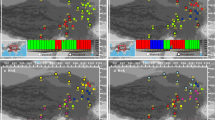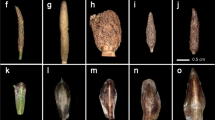Abstract
There are several well-documented examples of multiple hybrid origins of polyploid species. Herein we report the first, to our knowledge, explicit example of a species that most probably has originated recurrently by diploid hybrid speciation. Genetic relationships and stabilization of twoArgyranthemum populations of putative hybrid origin on Tenerife, the Canary Islands, were investigated using chromosomal, morphometric, and fertility analyses of cultivated progeny families and artificial F1 and F2 hybrids. These data were compared to a recently published chloroplast DNA phylogeny of the genus, in which the same populations were included. The results suggest that the two populations must be referred to a single species,A. sundingii, which is diploid, fully fertile, genetically stabilized, and occurs in an ecologically intermediate habitat opened by deforestation, and that this species has originated at least twice following local hybridization in two valleys. The same parental species were involved in each origin; the montaneA. broussonetii and the coastalA. frutescens. The montane species was the chloroplast donor in one of the valleys and the coastal species in the other.
Similar content being viewed by others
References
Abbott R. J. (1992) Plant invasions, interspecific hybridization and the evolution of new plant taxa. Trends Ecol. Evol. 7: 401–405.
Arnold M. L. (1992) Natural hybridization as an evolutionary process. Ann. Rev. Ecol. Syst. 23: 237–261.
Arnold M. L. (1997) Natural hybridization and evolution. Oxford Univ. Press, New York.
Ashton P. A., Abbott R. J. (1992) Multiple origins and genetic diversity in the newly arisen allopolyploid species,Senecio cambrensis Rosser (Compositae). Heredity 68: 25–32.
Borgen L. (1976) Analysis of a hybrid swarm betweenArgyranthemum adauctum andA. filifolium in the Canary Islands. Norw. J. Bot. 23: 121–137.
Borgen L. (1980) A new species ofArgyranthemum (Compositae) from the Canary Islands. Norw. J. Bot. 27: 163–165.
Borgen L. (1984) Biosystematics of Macaronesian flowering plants. In: Grant W. F. (ed.) Plant biosystematics. Academic Press, Toronto, pp. 477–496.
Brochmann C. (1984) Hybridization and distribution ofArgyranthemum coronopifolium (Asteraceae: Anthemideae) in the Canary Islands. Nord. J. Bot. 4: 729–736.
Brochmann C. (1987) Evaluation of some methods for hybrid analysis, exemplified by hybridization inArgyranthemum (Asteraceae). Nord. J. Bot. 7: 609–630.
Brochmann C., Soltis P. S., Soltis D. E. (1992a) Multiple origins of the octoploid Scandinavian endemicDraba cacuminum: electrophoretic and morphological evidence. Nord. J. Bot. 12: 257–272.
Brochmann C., Soltis P. S., Soltis D. E. (1992b) Recurrent formation and polyphyly of Nordic polyploids inDraba (Brassicaceae). Amer. J. Bot. 79: 673–688.
Brochmann C., Xiang Q.-Y., Brunsfeld S. J., Soltis D. E., Soltis P. S. (1998) Molecular evidence for polyploid origins inSaxifraga (Saxifragaceae): the narrow arctic endemicS. svalbardensis and its widespread allies. Amer. J. Bot. 85: 135–143.
Francisco-Ortega J., Crawford D. J., Santos-Guerra A., Carvalho J. A. (1996a) Isozyme differentiation in the endemic genusArgyranthemum (Asteraceae: Anthemideae) in the Macaronesian islands. Plant Syst. Evol. 202: 137–152.
Francisco-Ortega J., Jansen R. K., Santos-Guerra A. (1996b) Chloroplast DNA evidence of colonization, adaptive radiation, and hybridization in the evolution of the Macaronesian flora. Proc. Natl. Acad. Sci. USA 93: 4085–4090.
Francisco-Ortega J., Crawford D. J., Santos-Guerra A., Jansen R. K. (1997a) Origin and evolution ofArgyranthemum (Asteraceae: Anthemideae) in Macaronesia. In: Givnish T. J., Sytsma K. J. (eds.) Molecular evolution and adaptive radiation. Cambridge Univ. Press, New York, pp. 407–431.
Gottlieb L. D. (1972) Levels of confidence in the analysis of hybridization in plants. Ann. Miss. Bot. Gard. 59: 435–446.
Humphries C. J. (1976a) A revision of the Macaronesian genusArgyranthemum Webb ex Schultz Bip. (Compositae — Anthemideae). Bull. Br. Mus. nat. Hist. Bot. 5: 147–240.
Humphries C. J. (1976b) Evolution and endemism inArgyranthemum Webb ex Schultz Bip. (Compositae — Anthemideae). Bot. Macaronesica 1: 25–50.
Johansen D. A. (1940) Plant microtechnique. McGraw-Hill, New York.
Norusis M. J. (1986) SPSS/PC+. Advanced statistics. SPSS Inc., Chicago.
Radford A. E., Dickison W. C., Massey J. R., Bell C. R. (1974) Vascular plant systematics. Harper and Row, New York.
Ranker T. A., Haufler C. H., Soltis P. S., Soltis D. E. (1989) Genetic evidence for allopolyploidy in the Neotropical fernHemionitis pinnatifida (Adiantaceae) and the reconstruction of an ancestral genome. Syst. Bot. 14: 439–447.
Rieseberg L. H. (1991) Homoploid reticulate evolution inHelianthus (Asteraceae): evidence from ribosomal genes. Amer. J. Bot. 78: 1218–1237.
Rieseberg L. H. (1995) The role of hybridization in evolution: old wine in new skins. Amer. J. Bot. 82: 944–953.
Rieseberg L. H. (1997) Hybrid origins of plant species. Ann. Rev. Ecol. Syst. 28: 359–389.
Rieseberg L. H., Brunsfeld S. J. (1992) Molecular evidence and plant introgression. In: Soltis D. E., Soltis P. S., Doyle J. J. (eds.) Plant molecular systematics. Chapman and Hall, New York, pp. 151–176.
Rieseberg L. H., Soltis D. E., Palmer J. D. (1988) A molecular reexamination of introgression betweenHelianthus annuus andH. bolanderi (Compositae). Evolution 42: 227–238.
Rieseberg L. H., Wendel J. F. (1993) Introgression and its consequences in plants. In: Harrison R. G. (ed.) Hybrid zones and the evolutionary process. Oxford Univ. Press, Oxford, pp. 70–109.
Soltis D. E., Soltis P. S. (1989) Allopolyploid speciation inTragopogon: insights from chloroplast DNA. Amer. J. Bot. 76: 1119–1124.
Soltis D. E., Soltis P. S. (1990) Chloroplast DNA and nuclear rDNA variation: insights into autopolyploid and allopolyploid evolution. In: Kawano S. (ed.) Biological approaches and evolutionary trends in plants. Academic Press, London, pp. 97–117.
Soltis D. E., Soltis P. S. (1993) Molecular data and the dynamic nature of polyploidy. Crit. Rev. Plant Biol. 12: 243–273.
Soltis P. S., Plunkett G. M., Novak S. J., Soltis D. E. (1995) Genetic variation inTragopogon species: additional origins of the allotetraploidsT. mirus andT. miscellus (Compositae). Amer. J. Bot. 82: 1329–1341.
Steen S. W., Taberlet P., Gielly L., Brochmann C. (in press) Same parental species, but different taxa: molecular evidence for hybrid origins of the rare endemicsSaxifraga opdalensis andS. svalbardensis. Bot. J. Linn. Soc.
Werth C. R., Guttman S. I., Eshbaugh W. H. (1985) Recurring origins of allopolyploid species inAsplenium. Science 228: 731–733.
Wildpret W., del Arco M. (1987) Espana Insular: Las Canarias. In: Peinado M., Rivas-Martinez S. (eds.) La vegetación de Espana. Ser. Publicaciónes Univ. Alcala, Coleccion Aula Abierte 3, pp. 515–544.
Wolfe A. D., Xiang Q.-Y., Kephart S. R. (1998a) Assessing hybridization in natural populations ofPenstemon (Scrophulariaceae) using hypervariable intersimple sequence repeat (ISSR) bands. Molecular Ecology 7: 1107–1125.
Wolfe A. D., Xiang Q.-Y., Kephart S. R. (1998b) Diploid hybrid speciation inPenstemon (Scrophulariaceae). Proc. Natl. Acad. Sci. USA 95: 5112–5115.
Author information
Authors and Affiliations
Corresponding author
Rights and permissions
About this article
Cite this article
Brochmann, C., Borgen, L. & Stabbetorp, O.E. Multiple diploid hybrid speciation of the Canary Island endemicArgyranthemum sundingii (Asteraceae). Pl Syst Evol 220, 77–92 (2000). https://doi.org/10.1007/BF00985372
Received:
Accepted:
Issue Date:
DOI: https://doi.org/10.1007/BF00985372




